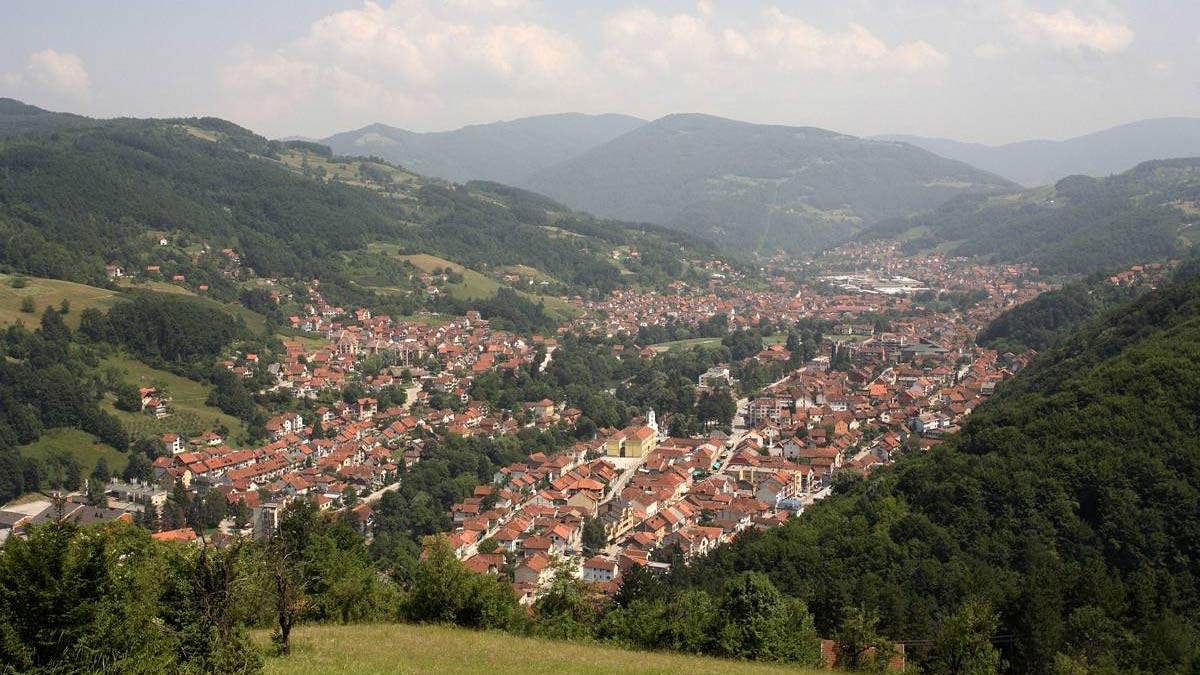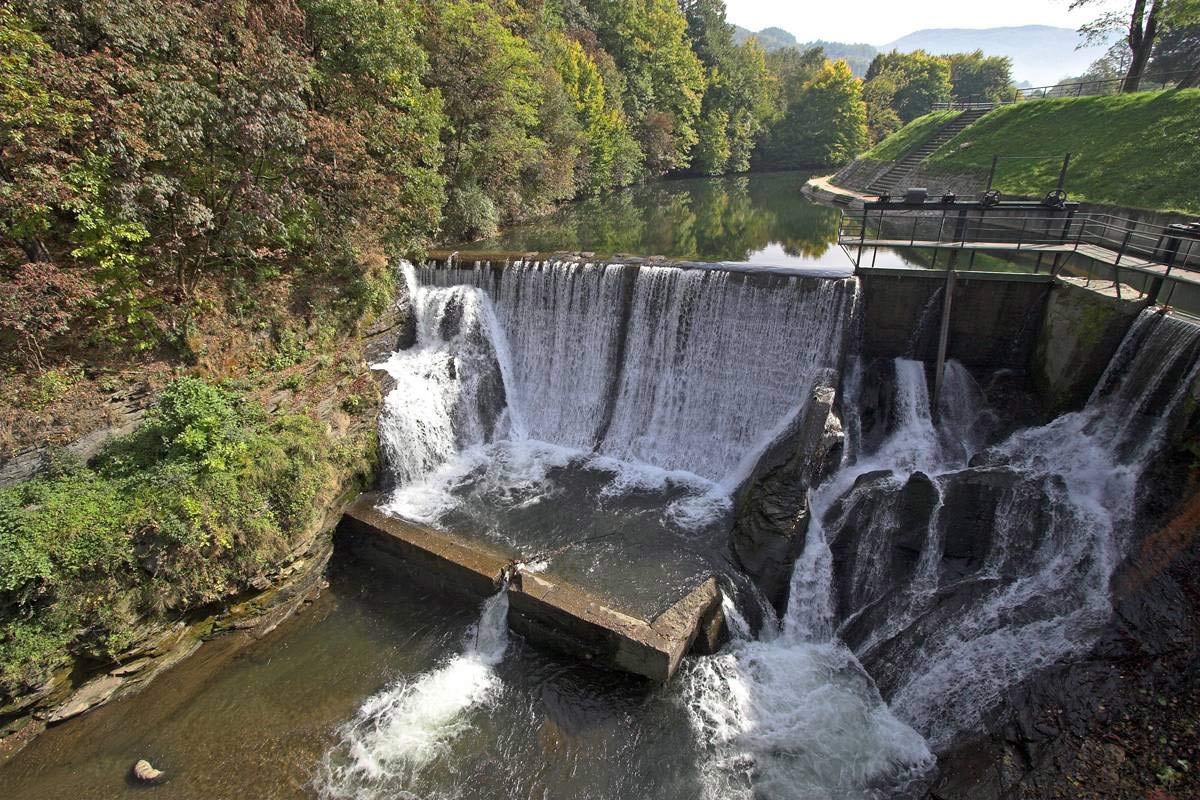ABOUT IVANJICI

The territory of the municipality of IVANJICA lies in the south- west of Serbia, covering a part of the Stari Vlah and Raška plateau also known as ‘Moravički Region’.
The town was established in 1833 by captain Sima Jaković, fol- lowing a decree of Knyaz Miloš. The borders of the Moravički Stari Vlah region is drawn by the 19°55’ and 20°23’ Eastern longitude and 43°17’ and 43°58’ of northern latitude, outlining the area of one of the largest municipalities in Serbia, covering a total of 1090 km2 . According to the recent census in 2011, the population of the municipality is 32.000, while the town itself has just un- der 12.000 citizens. The bordering municipalities include Sjenica, Nova Varoš, Raška, Novi Pazar, Kraljevo, Lučani and Arilje. Lying at 224 kilometres south of Belgrade, Ivanjica is surrounded with a network of good asphalt roads, connecting it with major centres in the neighbouring municipalities.
Ivanjica is the administrative, cultural and economic centre of the municipality, and together with the municipalities of Lučani, Čačak and Gornji Milanovac constitutes the Moravički Region. Lying at 468 m above the sea level, the town stretches on the banks of the Moravica River, not far from its source on the Golija mountain.
A decree passed by the Government of Serbia as at 26th January 2000 granted Ivanjica the status of an Air Spa.
The road leading to Arilje and Požega connects Ivanjica with the route leading to the Adriatic Sea and the Belgrade-Bar railroad. Taking the eastern direction from the same road, one reaches Guča and Čačak, and the road passing through Kaona leads further on to Kraljevo. On the other side, passing through Sjenica, the mountain road leads on to Novi Pazar and beyond, to the Ibarska magistrala regional road. Taking a different route from Sjenica, it is possible to reach Nova Varoš and Prijepolje and further south, all the way to Montenegro and the Adriatic Coast.
There are 18 local communities within the Municipality, Ostatija being the largest in terms of the land area, and Ivanjica having the largest population. One half of the total area of the municipality (540 km2 ) is covered in woods, while most of the other half is farming land, with only a tiny portion of infertile land (37 km2 ).
Apart from the hotels in the town and the neighbouring villag- es, visitors are offered accommodation in private suites and rooms in the villages and the town.

The Ivanjica municipality employs about 5,000 workers in the public and private sectors, both in the economy and non-economy. Many state and socially-owned companies have been privatized (ŠPIK, Javor, Graditelj …), and some are waiting to be privatized.
Of the cultural and historical monuments, we single out the Church of St. Emperor Constantine and Empress Helen erected 1836-1838. year, the stone bridge on the river Moravica was built from 1904-1906. It is one of the largest single-arched bridges in the Balkans. The power plant on Moravica was built in 1911 and it was the seventh hydroelectric power plant in Serbia, with a waterfall which is the visual symbol of Ivanjica. A monument to General Draža Mihailović was recently erected in the city center. Near the town is the Palibrčki tomb, on which a church was erected on the tomb of Boško Jugović (Kosovo’s hero) dedicated to St. Prince Lazar as well as the Kovilje Monastery which dates from the 13th century and is 25 km away from Ivanjica.

Hadzi-Prodan’s cave is a combination of an important tourist, speleological and archeological object. It is located near the city at only 7 kilometers at an altitude of 600 m. It is located in the valley of the Rašćanska river, so it is also called Rašćanska. In addition to the beautiful halls with stalagmites and stalactites, valuable objects from prehistoric times were found in the cave. It is open for tourist visits.
Going upstream on the river Moravica, 15 km from Ivanjica, the mountain Golija begins to rise – a biosphere reserve declared by the MAB / UNESCO committee on September 15, 2001. within the Nature Park on an area of 53,804 ha until recently the only one in our country and one of more than 200 reserves in the world. If we wanted to talk all about this mountain beauty, it would take us a few days, but we should definitely mention the untouched nature with dense forests, Tičar (Daićko) lake on Daićko hill at an altitude of 1500 m, then the lake on Okruglica created in the 70s last century, after the earthquake in Romania and Košaninovo Lake, which was overgrown with Tresav vegetation.
There are also beautiful waterfalls on the river Izubra that captivate with their beauty. When you climb to the top of Golija, you have the impression that you are at the top of the world, because before your eyes you can see where you see half of Serbia and realize that you are on a mountain that rises above other old Vlach mountains like an island on the rising sea. Its beautiful terrains with a lot of snowy days in the year are ideal for the development of winter sports as well as the overall development of Mount Golija. It is not necessary to skip, ie. not to mention a lot of springs with pure mountain water, over 100 species of medicinal plants, many wild animals and rivers and streams full of tribal fish (brown trout, perch, etc …). On Golija you can stay in the Mountain Lodge Golijska reka (Currently not open for visits) which is located in the heart of Golija with its 30 beds as well as private accommodation through the local Tourist Organization.
Javor – a historically famous mountain – the border between Serbia and the Turkish Empire until 1912, does not lag far behind Golija in its natural beauty. It is overgrown with deciduous forests and is known for frequent springs of clean water. The highest peak is “Vasilijin vrh”, 1520 m above sea level, below which there is a monument to Major Ilić, a hero of the Javor War. Walking through the clear pastures, you will still find traces of the watchtower and the walls of the customs house. The village of Kušići – 12 km from Javor towards Ivanjica is today a very interesting place for tourists, due to the ideal altitude of about 1000 m, pine forest, concentration of ions and wind roses and as such represent a suitable place for the treatment of bronchitis and asthma. In this village, rural tourism has been expanding lately, and accommodation is also possible in the hotel “Javor”, which has 94 beds, Villa Angelina and other private accommodation. By the way, the widely known “Ivanjica potatoes” are grown in this area.
Hunting and fishing within the hunting and fishing tourism in our municipality occupy an important place. Every year, the traditional “Wolf Hunt” is held on Golija, the largest manifestation of that type in terms of the number of participants in the country. There is a brook trout hatchery in “Braduljička reka” – the only one in the country where brook trout spawn and restocks rivers with it, both in Ivanjica municipality and abroad.
Sports in Ivanjica have been organized since 1912 with the founding of FC “Javor”, which competes in the Federal Football League, then the Volleyball Club “Roads”, BC “Javor”, Chess Club, Athletic Club, Karate Club and many others, and it should be noted and that Ivanjica is a volleyball camp of the national team and that it has excellent conditions for the preparation of sports teams, both because of the ideal altitude, favorable climatic conditions and because of the ecologically healthy food and rich table that is offered to guests, especially athletes.
In Ivanjica they have two grass football fields, two halls (one larger and one smaller), several fields for small sports, two indoor swimming pools, gyms, saunas, athletic tracks, marked trails in nature and many other facilities available to athletes who come. in Ivanjica for preparations. The construction of a small sports center on “Jelića polje” is also planned.


